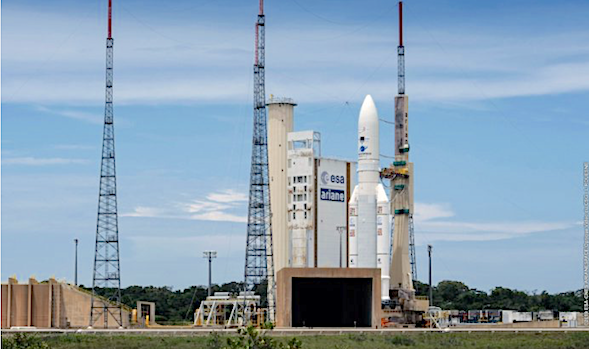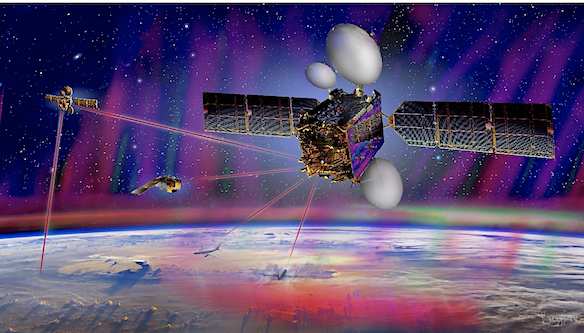
Ariane 5 is in the launch zone for tomorrow’s heavy-lift Arianespace mission

With Intelsat 39 and EDRS-C under its payload fairing, Ariane 5 approaches the launch pad to complete today’s rollout.
Arianespace has delivered another Ariane 5 to the launch zone at Europe’s Spaceport in French Guiana, positioning this workhorse vehicle for its August 6 liftoff with two telecommunications satellites: Intelsat 39 and EDRS-C.
Riding atop a mobile launch table, Ariane 5 was transferred to the ELA-3 launch zone from the Spaceport’s Final Assembly Building – where its two passengers were integrated as part of pre-flight preparations. The launcher is delivered to Arianespace by ArianeGroup as production prime contractor.
With the rollout completed, the final countdown will begin for a Tuesday liftoff at the start of a 2-hour, 21-minute launch window opening at 4:30 p.m. local time in French Guiana.
For this 105th flight of an Ariane 5, the payload lift performance to geostationary transfer orbit is approximately 10,660 kg. – a total that factors in Intelsat 39 and EDRS-C, plus the launch vehicle’s dual-passenger dispenser system and satellite integration hardware.
Delivering connectivity with Intelsat 39
Intelsat 39 – built by Maxar for global operator Intelsat – is the mission’s upper passenger and will be released first in the flight sequence 29 minutes after liftoff.
It was designed with both wide and high-powered steerable spot beams to meet the needs of broadband networking, video and government customers across Africa, Asia, Europe, the Middle East and Indian Ocean region. The steerable spot beams provide flexibility within the payload and enable customers to rapidly and efficiently respond to shifts in geographic or application requirements.
The satellite features C-and Ku-band capabilities to provide additional scale for Intelsat’s Flex managed service and enhance mobile connectivity for aero, maritime and government users operating across these regions.
EDRS-C: enhancing the SpaceDataHighway
EDRS-C – to be deployed from Ariane 5’s lower passenger position – is the second node of the SpaceDataHighway network, a public-private partnership between Airbus and the European Space Agency. This spacecraft’s separation will occur 33 min. after liftoff, completing the August 6 mission.
Permanently fixed over a network of ground stations, the SpaceDataHighway will help improve environmental and security monitoring, disaster response and crisis management. EDRS-C – based on a satellite platform supplied by OHB System – will be able to connect low-orbiting observation satellites via laser at a distance up to 45,000 km., as well as unmanned aerial vehicles or mission aircraft.
EDRS-C also carries a hosted payload – HYLAS 3 – which was provided by Avanti Communications under a contract with ESA as a customer-furnished item to OHB.
Launch window for Flight VA249:

Intelsat 39: Faster, more efficient connectivity
Built by Maxar Technologies, Intelsat 39 is designed with both wide and high-powered steerable spot beams to meet the needs of broadband networking, video and government customers across Africa, Asia, Europe, the Middle East and Indian Ocean region. The steerable spot beams provide flexibility within the payload and enable customers to rapidly and efficiently respond to shifts in geographic or application requirements.
The satellite features C-and Ku-band capabilities to provide additional scale for Intelsat’s Flex managed service and enhance mobile connectivity for aero, maritime and government users operating across these regions.
Intelsat 39 will be the 61st Intelsat spacecraft launched on an Arianespace mission, continuing a partnership that extends back to 1983. The satellite will replace Intelsat 902 – lofted by Arianespace in 2011 – at an orbital position of 62 deg. East.
The satellite features C-and Ku-band capabilities to provide additional scale for Intelsat’s Flex managed service and enhance mobile connectivity for aero, maritime and government users operating across these regions.
Intelsat 39 is a powerful platform that will enable mobile network operators, enterprises and internet service providers to deliver faster and more efficient connectivity services. It will also provide government entities with the ability to expand connectivity to more remote areas and continue to narrow the digital divide. Intelsat 39 is based on the powerful 1300 platform, which has the flexibility to support a broad range of applications and technology advances, including electric propulsion.
Intelsat 39 was built by Maxar in Palo Alto, California
Intelsat 39 will be the 57th satellite based on a Maxar 1300 platform launched by Arianespace.
EDRS-C: Expanding the SpaceDataHighway

EDRS-C – based on a satellite platform supplied by OHB System – is the second node of the SpaceDataHighway, which is the world’s first “optical fiber” network in the sky based on cutting-edge laser technology. Permanently fixed over a network of ground stations, the SpaceDataHighway will help improve environmental and security monitoring, disaster response and crisis management.
To be positioned at 31 deg. East, EDRS-C will be able to connect low-orbiting observation satellites via laser at a distance up to 45,000 km., as well as unmanned aerial vehicles or mission aircraft.
The SpaceDataHighway is a public–private partnership between Airbus and the European Space Agency (ESA), with the laser terminals developed by Tesat-Spacecom and Germany’s DLR Aerospace Center. Airbus owns, operates and provides services for the SpaceDataHighway. EDRS-C will be the 132nd satellite launched by Arianespace at the service of Airbus, as well as its 52nd mission for ESA.
EDRS-C also carries a hosted payload – HYLAS 3 – which was provided by Avanti Communications under a contract with ESA as a customer-furnished item to OHB.
It is a unique network of geostationary satellites permanently fixed over a network of ground stations that can transmit data at a rate of 1.8 Gbit/s It will help to improve environmental and security monitoring, disaster response and crisis management.
As a result, Arianespace offers an independent access to space for European flagship programs.
The SpaceDataHighway system will relay larger volumes of image data in a secure way. From its position in geostationary orbit, the SpaceDataHighway system relays data collected by observation satellites to Earth in near-real-time, a process that would normally take several hours. It thus enables the quantity of image and video data transmitted by observation satellites to be tripled and their mission plan to be reprogrammed at any time and in just a few minutes.
Launched into a geostationary orbit at 31 degrees East, EDRS-C will be able to connect low-orbiting observation satellites via laser at a distance up to 45,000 km., as well as intelligence UAVs or mission aircraft. The SpaceDataHighway is a public–private partnership between the European Space Agency (ESA) and Airbus, with the laser terminals developed by Tesat-Spacecom and Germany’s DLR Aerospace Center. Airbus owns, operates and provides services for the SpaceDataHighway. The EDRS-C satellite platform is supplied by OHB System AG.
In addition, a hosted payload – HYLAS 3 – was provided by Avanti Communications under a contract with ESA as a customer-furnished item to OHB.
EDRS-C/HYLAS 3 will be: the 132th satellite launched for Airbus by Arianespace, the 26th satellite based on an OHB platform; and the fourth Avanti payload to be launched by Arianespace.

